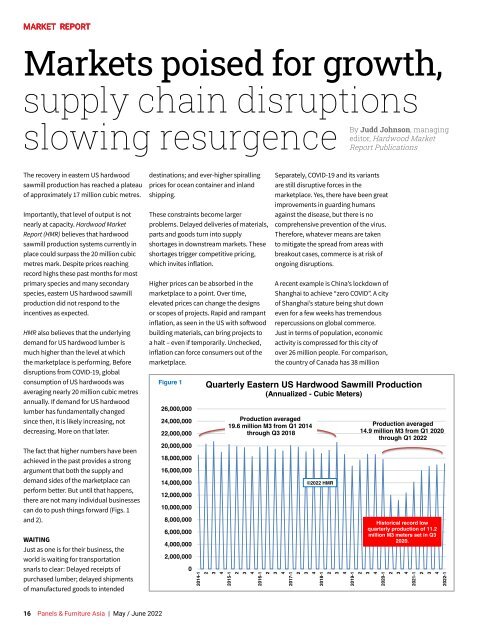Panels & Furniture Asia May/June 2022
Panels & Furniture Asia (PFA) is a leading regional trade magazine dedicated to the woodbased panel, furniture and flooring processing industry. Published bi-monthly since 2000, PFA delivers authentic journalism to cover the latest news, technology, machinery, projects, products and trade events throughout the sector. With a hardcopy and digital readership comprising manufacturers, designers and specifiers, among others, PFA is the platform of choice for connecting brands across the global woodworking landscape.
Panels & Furniture Asia (PFA) is a leading regional trade magazine dedicated to the woodbased panel, furniture and flooring processing industry. Published bi-monthly since 2000, PFA delivers authentic journalism to cover the latest news, technology, machinery, projects, products and trade events throughout the sector. With a hardcopy and digital readership comprising manufacturers, designers and specifiers, among others, PFA is the platform of choice for connecting brands across the global woodworking landscape.
Create successful ePaper yourself
Turn your PDF publications into a flip-book with our unique Google optimized e-Paper software.
MARKET REPORT<br />
Markets poised for growth,<br />
supply chain disruptions<br />
slowing resurgence<br />
By Judd Johnson, managing<br />
editor, Hardwood Market<br />
Report Publications<br />
The recovery in eastern US hardwood<br />
sawmill production has reached a plateau<br />
of approximately 17 million cubic metres.<br />
Importantly, that level of output is not<br />
nearly at capacity. Hardwood Market<br />
Report (HMR) believes that hardwood<br />
sawmill production systems currently in<br />
place could surpass the 20 million cubic<br />
metres mark. Despite prices reaching<br />
record highs these past months for most<br />
primary species and many secondary<br />
species, eastern US hardwood sawmill<br />
production did not respond to the<br />
incentives as expected.<br />
HMR also believes that the underlying<br />
demand for US hardwood lumber is<br />
much higher than the level at which<br />
the marketplace is performing. Before<br />
disruptions from COVID-19, global<br />
consumption of US hardwoods was<br />
averaging nearly 20 million cubic metres<br />
annually. If demand for US hardwood<br />
lumber has fundamentally changed<br />
since then, it is likely increasing, not<br />
decreasing. More on that later.<br />
The fact that higher numbers have been<br />
achieved in the past provides a strong<br />
argument that both the supply and<br />
demand sides of the marketplace can<br />
perform better. But until that happens,<br />
there are not many individual businesses<br />
can do to push things forward (Figs. 1<br />
and 2).<br />
WAITING<br />
Just as one is for their business, the<br />
world is waiting for transportation<br />
snarls to clear: Delayed receipts of<br />
purchased lumber; delayed shipments<br />
of manufactured goods to intended<br />
destinations; and ever-higher spiralling<br />
prices for ocean container and inland<br />
shipping.<br />
These constraints become larger<br />
problems. Delayed deliveries of materials,<br />
parts and goods turn into supply<br />
shortages in downstream markets. These<br />
shortages trigger competitive pricing,<br />
which invites inflation.<br />
Higher prices can be absorbed in the<br />
marketplace to a point. Over time,<br />
elevated prices can change the designs<br />
or scopes of projects. Rapid and rampant<br />
inflation, as seen in the US with softwood<br />
building materials, can bring projects to<br />
a halt – even if temporarily. Unchecked,<br />
inflation can force consumers out of the<br />
marketplace.<br />
Figure 1<br />
26,000,000<br />
24,000,000<br />
22,000,000<br />
20,000,000<br />
18,000,000<br />
16,000,000<br />
14,000,000<br />
12,000,000<br />
10,000,000<br />
8,000,000<br />
6,000,000<br />
4,000,000<br />
2,000,000<br />
0<br />
2014-1<br />
2<br />
3<br />
4<br />
2015-1<br />
2<br />
3<br />
4<br />
2016-1<br />
2<br />
Separately, COVID-19 and its variants<br />
are still disruptive forces in the<br />
marketplace. Yes, there have been great<br />
improvements in guarding humans<br />
against the disease, but there is no<br />
comprehensive prevention of the virus.<br />
Therefore, whatever means are taken<br />
to mitigate the spread from areas with<br />
breakout cases, commerce is at risk of<br />
ongoing disruptions.<br />
A recent example is China’s lockdown of<br />
Shanghai to achieve “zero COVID”. A city<br />
of Shanghai’s stature being shut down<br />
even for a few weeks has tremendous<br />
repercussions on global commerce.<br />
Just in terms of population, economic<br />
activity is compressed for this city of<br />
over 26 million people. For comparison,<br />
the country of Canada has 38 million<br />
Quarterly Eastern US Hardwood Sawmill Production<br />
(Annualized - Cubic Meters)<br />
Production averaged<br />
19.6 million M3 from Q1 2014<br />
through Q3 2018<br />
3<br />
4<br />
2017-1<br />
2<br />
3<br />
©<strong>2022</strong> HMR<br />
4<br />
2018-1<br />
2<br />
3<br />
4<br />
2019-1<br />
Production averaged<br />
14.9 million M3 from Q1 2020<br />
through Q1 <strong>2022</strong><br />
2<br />
Historical record low<br />
quarterly production of 11.2<br />
million M3 meters set in Q3<br />
2020.<br />
3<br />
4<br />
2020-1<br />
2<br />
3<br />
4<br />
2021-1<br />
2<br />
3<br />
4<br />
<strong>2022</strong>-1<br />
16 <strong>Panels</strong> & <strong>Furniture</strong> <strong>Asia</strong> | <strong>May</strong> / <strong>June</strong> <strong>2022</strong>


















